The headlines, tweets and rumor mill all seem to resonate the same message as we head into 2023: Hold onto your hat for 2023 crop input prices and availability. When such concerns arise, growers and their agronomists have looked toward those of us in the nutrient management field for help in making manure the hero. Manure is an excellent fertilizer source and soil amendment as it supplies the nutrients needed for crop production. It can also improve soil health and quality thanks to its organic matter. But in order for manure to carry this heavy torch in the year ahead, producers need to take their manure management to the next level.
For manure to save this ship, it’s important to know its nutrient value. Knowing what is actually available can help make informed decisions for the 2023 growing season. You can’t manage what you don’t measure. Weather, management practices and other conditions all affect the nutrient content of manure. And sampling manure – while not glamorous – is essential.
Plan it out
Frequent manure sampling is the best way to identify trends and gain an understanding of baseline recommendations. However, every farm manages its manure sources differently, and frequent sampling isn’t always feasible. I recommend at least annual sampling to my clients, but increase that frequency to each hauling season when working with liquid manure. In these liquid manure systems, sampling should be completed after agitation, and several subsamples should be pulled throughout pumping. These can then be combined to form a composite sample for analysis.
Leveling up manure management also means getting your team all on the same page. The only way to ensure the sampling frequency you’ve decided on is to adequately equip those working with manure. I suggest supplying the custom manure hauler with sampling supplies upon arrival or delegating the job to a specific team member on or off the farm. Typically, the sampling supplies needed can be collected from the laboratory set to receive the samples. They will likely also supply additional directions to ensure any shipped samples don’t cause a mess in the mail. As valuable as manure is, I don’t think anyone from the postal service, or even the laboratory, can pretend to be comfortable with incorrectly packaged samples that break open in transit. The horror stories amassed in our lab are enough to make anyone double-check the enclosure before shipment.
Analysis backed by certification
Choosing a lab for your samples shouldn’t be taken lightly. Much like nutrition, working with a reputable laboratory is pertinent if manure is going to be carrying the nutrient load for acres in 2023. And working with a certified manure analysis laboratory ensures accurate manure analysis results. They have a track record of providing consistent sample results using the approved analysis procedures outlined by the University of Minnesota. To gain and maintain certification, the department deploys blind samples to the laboratories for analysis on a quarterly basis. They are then scored based on the results of the analysis. If unable to pass proficiency rounds, laboratories must complete and pass a retest to be recertified. Certified laboratories are enrolled with and report data to the Minnesota Department of Ag Manure Analysis Proficiency Program, but the certification spans nationally.
Is the dirty work worth it?
Nutrients must be managed carefully. Statistical analysis of liquid dairy manure samples analyzed at Rock River Laboratory between 2021 and 2022 showed tremendous variability. The average total nitrogen value was 16.4 pounds per 1,000 gallons, with a normal range of 11.9 to 21 pounds of total nitrogen per 1,000 gallons.
The nitrogen cycle is one of the most important cycles to all living organisms, and nitrogen is one of the most challenging nutrients to manage. Not all nitrogen in manure is immediately available for crop uptake, so knowing the nitrogen breakdown can help inform best management practices in manure handling. Whether it comes from manure or fertilizers, it is mobile both in the soil and in the plant. The nitrate form of nitrogen is Wisconsin’s leading cause of groundwater contamination. It is estimated that 90% of nitrate in groundwater is due to fertilizer and manure applications.
Meanwhile, the overapplication of phosphorus fertilizers and manure degrades surface water quality. The average phosphorus value in that same statistical analysis of liquid dairy manure mentioned prior was 6.88 pounds of total phosphorus with a range of 4.04 to 9.46 pounds of total phosphorus per 1,000 gallons. Unlike nitrogen, phosphorus is primarily immobile in the soil, and phosphorus loss is driven by erosion.
The most accurate way to manage manure for nutrients is to sample and analyze the nutrient content. Manure testing not only helps farmers make informed decisions at the field level, but it also helps to create book values for the entire state. Knowing the nutrient content of the available manure is also the first step in reducing the overapplication of these key nutrients. And it's a great way to understand the true value of what is applied. In reviewing information from my nutrient management colleague Scott Fleming and the 2021 Iowa Farm Custom Rate Survey, even with application costs considered, for every $1 spent on application of liquid dairy manure, users are receiving almost $2 back in fertilizer. With such impressive value, sampling manure seems like a no-brainer from several angles.
Management of any resource usually requires employing a few different tactics and a little extra work. Manure is no different. But in doing so, more-informed decisions are made. Through management – including analysis and evaluation – farmers can utilize the available nutrients appropriately and look to reduce other fertilizer costs as they plan for the year ahead. The goal of nutrient management is to adequately supply soils and plants with the nutrients necessary to produce food, forage, fiber and cover, while minimizing the transport of nutrients to the ground and surface waters. The management practices discussed here can do just that, all while adding peace of mind and value to the bottom line.


.jpg?t=1687979285&width=640)




